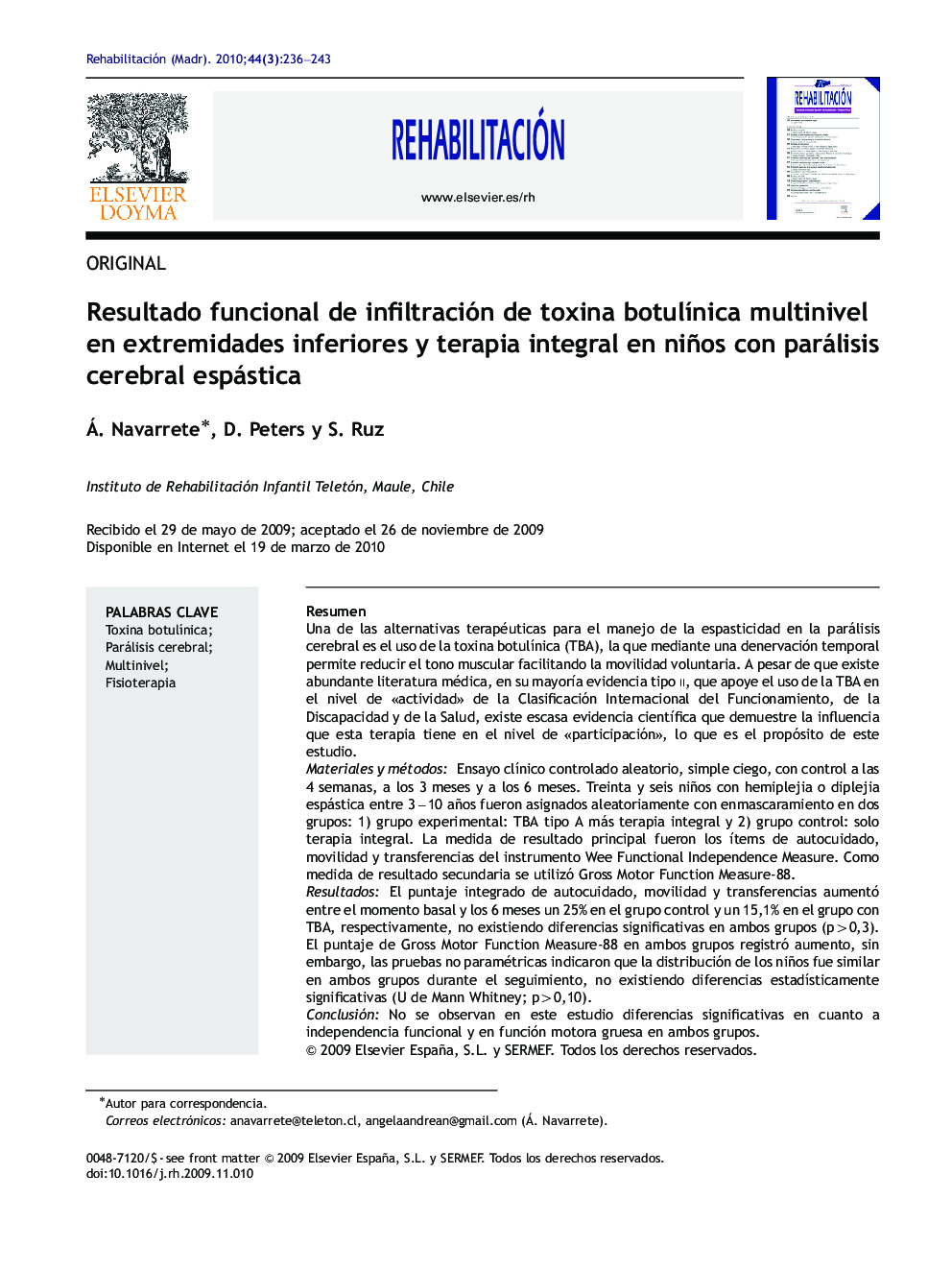| کد مقاله | کد نشریه | سال انتشار | مقاله انگلیسی | نسخه تمام متن |
|---|---|---|---|---|
| 4084888 | 1267816 | 2010 | 8 صفحه PDF | دانلود رایگان |

ResumenUna de las alternativas terapéuticas para el manejo de la espasticidad en la parálisis cerebral es el uso de la toxina botulínica (TBA), la que mediante una denervación temporal permite reducir el tono muscular facilitando la movilidad voluntaria. A pesar de que existe abundante literatura médica, en su mayoría evidencia tipo ii, que apoye el uso de la TBA en el nivel de «actividad» de la Clasificación Internacional del Funcionamiento, de la Discapacidad y de la Salud, existe escasa evidencia científica que demuestre la influencia que esta terapia tiene en el nivel de «participación», lo que es el propósito de este estudio.Materiales y métodosEnsayo clínico controlado aleatorio, simple ciego, con control a las 4 semanas, a los 3 meses y a los 6 meses. Treinta y seis niños con hemiplejia o diplejia espástica entre 3 – 10 años fueron asignados aleatoriamente con enmascaramiento en dos grupos: 1) grupo experimental: TBA tipo A más terapia integral y 2) grupo control: solo terapia integral. La medida de resultado principal fueron los ítems de autocuidado, movilidad y transferencias del instrumento Wee Functional Independence Measure. Como medida de resultado secundaria se utilizó Gross Motor Function Measure-88.ResultadosEl puntaje integrado de autocuidado, movilidad y transferencias aumentó entre el momento basal y los 6 meses un 25% en el grupo control y un 15,1% en el grupo con TBA, respectivamente, no existiendo diferencias significativas en ambos grupos (p>0,3). El puntaje de Gross Motor Function Measure-88 en ambos grupos registró aumento, sin embargo, las pruebas no paramétricas indicaron que la distribución de los niños fue similar en ambos grupos durante el seguimiento, no existiendo diferencias estadísticamente significativas (U de Mann Whitney; p>0,10).ConclusiónNo se observan en este estudio diferencias significativas en cuanto a independencia funcional y en función motora gruesa en ambos grupos.
One of the therapeutic alternatives for the treatment of spasticity in cerebral palsy is the use of botulinum toxin, which, through a temporary denervation, makes it possible to reduce muscle tone, facilitating voluntary mobility. Even though there is abundant literature, mostly with type II evidence, that supports the use of botulinum toxin on the “activity” level of the International Classification of Functioning, Disability and Health, there is scant scientific evidence that demonstrates the influence this therapy has on the “participation” level, which is the purpose of this study.Material and methodsA randomized, single blind, controlled clinical trial with controls at 4 weeks, 3 and 6 months. Thirty-six children with hemiplegia or spastic diplegia between 3 – 10 years were randomly assigned with masking into two groups: experimental group with botulinum toxin A plus comprehensive therapy and control group with only comprehensive therapy. The primary endpoints measured were self-care, mobility and instrument transfer of the Wee Functional Independence Measure Instrument. The Gross Motor Function Measure-88 was used to measure the secondary results.ResultsThe weefim score of self-care, mobility and transfers increased 25.0% between baseline and 6 months in the control group and 15.1% in the botulinum toxin group, respectively, there being no statistically significant differences between both groups (p>0.3). An increase was recorded for the score on the Gross Motor Function Measure-88 in both groups. However, the non-parametric tests indicated that the distribution of the children was similar in both groups during the follow-up, there being no statistically significant differences (Mann Whitney U Test, p>0.10).ConclusionNo significant differences were observed in this study regarding functional independence and gross motor function in both groups.
Journal: Rehabilitación - Volume 44, Issue 3, July–September 2010, Pages 236–243